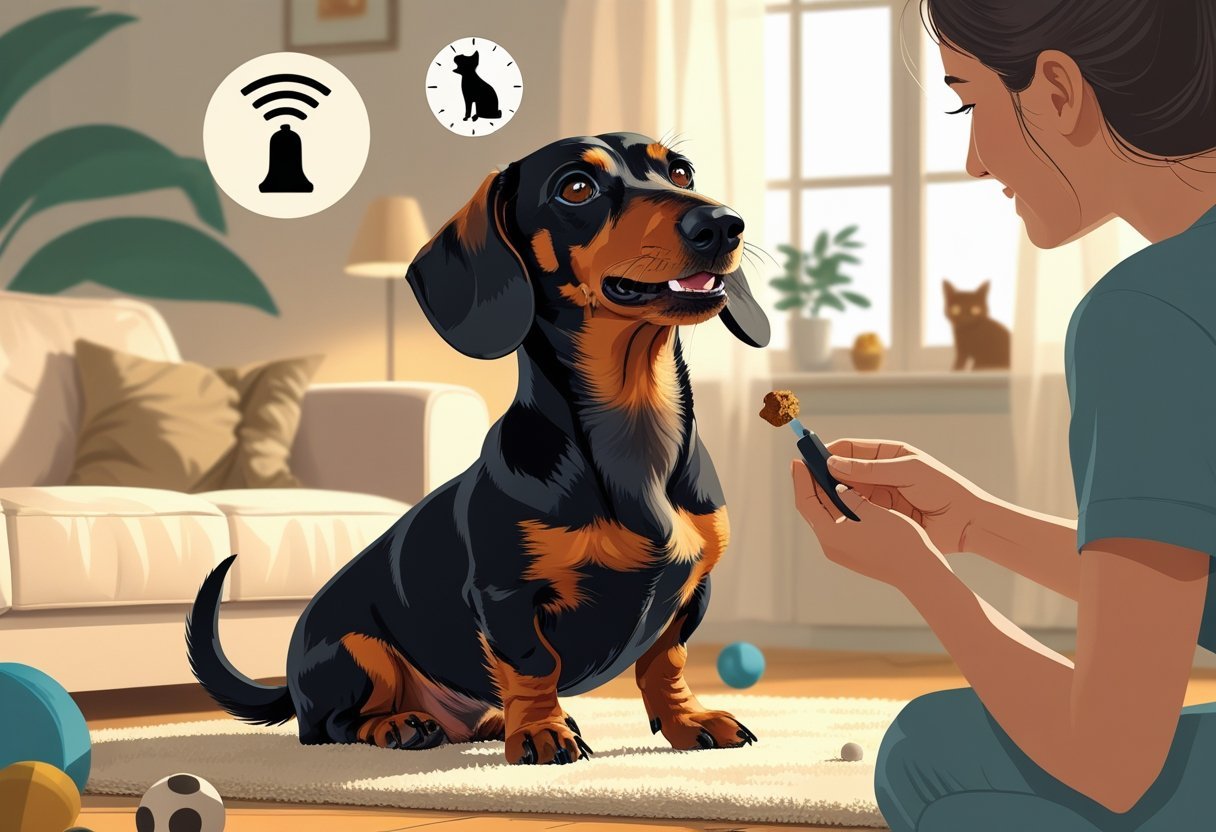Dachshunds are expressive little dogs with a quirky, unmistakable way of showing how they feel 🐾. Whether it’s a wagging tail or those alert, radar-dish ears 👂, these sausage-shaped buddies use every inch of their bodies to get their point across. If you learn to read your dachshund’s body language 🐶, you’ll respond better to their needs and build a closer bond 💛. Plus, it just makes life together smoother ✨.
It’s easy to miss what your doxie’s saying if you don’t know the signs 👀. They might be anxious, excited, or even hurting 💔, and they’ll show it with a subtle shift—maybe a droop in the ears, a change in posture, or a flicker in their eyes 🌟. If you pick up on these cues, you’ll avoid a lot of confusion and probably have a much happier relationship 🐕.
Key Takeaways 📌
- Dachshunds use tail positions, ear movements, and posture to show you how they feel 🐾.
- If you spot defensive signals like growling or a stiff body, you can steer clear of trouble 🚫.
- When you respond to their body language, you build trust and make your bond stronger ❤️.
🐾 Free Dachshund Care Guide
Download our free checklist to ensure your Dachshund stays happy, healthy, and well-loved!
Get Your Free Guide 🐶The Basics of Dachshund Body Language
Dachshunds send out clear signals with their bodies 🐾. If you learn to read them, you’ll get a much better sense of what your doxie wants or needs 💛.
Key Body Signals Unique to Dachshunds 🔍
Some dachshund signals are pretty unique ✨. That long, low body gives them a special way of moving, especially when they’re excited or on alert 🐶.
There’s the dachshund stretch—front legs out, rear up—which usually means, “Let’s play!” 🎾
Then there’s the dachshund shuffle. That’s when their hind end wiggles but the front stays still 🐕. It’s their way of saying they’re happy or thrilled to see you 💖.
Tail positions matter a lot 🚩. A high, waggy tail? That’s excitement. If it’s low or tucked, your doxie’s nervous or feeling small 😟.
Watch out for the back arch ⚠️. If their back suddenly arches more than usual, they might be uncomfortable or hurting—especially with their delicate spines 🩺.

🧠 Brain Training for Dogs – Unlock Your Doxie’s Full Potential
Fun, science-backed games that sharpen focus, reduce boredom, and help your Dachshund communicate more clearly through positive behavior.
- ✅ Improves obedience and impulse control
- ✅ Reduces anxiety-driven habits
- ✅ Keeps your doxie mentally engaged
Typical Postures and Movements 🐕🦺
Their posture gives away their mood 🌟. A relaxed dachshund moves loosely, with a neutral spine and easygoing steps 🌼.
When something catches their attention, they’ll stand tall, ears up, weight forward 👀. It’s their “What’s that?” stance 🐾.

The play bow—front down, rear up—is a classic “let’s play” move 🎯. Doxies sometimes throw in a goofy bounce for good measure 😄.
If your doxie paces or circles, they might feel anxious or just need a bathroom break 🚽. It’s their way of saying, “Hey, something’s up” 🌀.
And then there’s burrowing—digging at blankets or pillows 🛏️. That’s a throwback to their hunting days, and it usually means they feel cozy and safe 💤.
Common Facial Expressions 😊
Dachshund faces are full of clues 🎭. Ears tell a lot—forward means curious, flat means scared or unsure 😯.
Eyes are another giveaway 👁️. If they blink softly, they trust you 💖. Wide, staring eyes might mean they’re scared or even about to get feisty ⚡.
The dachshund smile—mouth open, gentle pant—shows they’re happy 🌞. That’s not the same as a stress pant, which is faster and a bit desperate 😬.
That famous head tilt? It usually means they’re trying to figure you out or just listening closely 🎧. Who can resist? 🥰
Lip licking or yawning (when there’s no food in sight) usually means your doxie’s stressed 😌. These are calming signals—their way of easing tension 🌿.
Reading Your Doxie’s Mood Through Body Language
Dachshunds are always “talking” with their bodies 🐾. If you pay attention, you’ll get a window into their feelings—sometimes even before they act out 👀.
Signs of Happiness and Relaxation 😊
A happy dachshund is easy to spot 🌟. Their whole body loosens up and they get that wiggly, silly energy 🎉.
Look for:
- Tail wagging in big sweeps or even circles 🐕
- Mouth open with a soft “Doxie smile” 😄
- Ears in a natural, relaxed spot 🐾
- Gentle, blinking eyes 👁️
- Rolling over to ask for belly rubs 💛
A play bow (front down, rear up) means they’re in the mood for fun 🎾. You might notice your doxie leaning against you or nudging your hand—just asking for a little love ❤️.
When they’re relaxed, their breathing is steady and their steps are bouncy, not stiff or careful 🌼.

📹 Petcube Cam 360
- ✅ Watch tail wags and stress signs in real-time
- ✅ Two-way talk to comfort your doxie from anywhere
- ✅ Motion alerts & night vision for peace of mind
🛰️ Tractive GPS Dog 4 Tracker
- ✅ Live location tracking to prevent escapes
- ✅ Activity & sleep insights for behavior monitoring
- ✅ Safe zone alerts for wander-prone doxies
Stress, Fear, and Anxious Signals 😟
Dachshunds get anxious just like anyone else, and they’ll show it if you watch closely 🔍.
Some common stress signs:
- Tucked tail (classic fear signal) 🚩
- Ears pinned back 🐕🦺
- Whale eye (white showing around the eyes) 👀
- Lots of yawning, licking lips, or panting 😮💨
- Raised hackles ⚡
- Stiff or trembling body ❄️

🎉 Grab your free Dachshund care checklist!
An anxious Doxie might pace, whine, or stick to you like glue 🤍. Some will hide under the couch or behind your legs if they’re really scared 🛋️.
Stress sometimes comes out as barking, chewing stuff up, or having accidents indoors 🐶. They’re not being bad—they’re just trying to tell you something’s off 📢.
Alertness and Curiosity in Dachshunds 🔎
Dachshunds have a built-in radar for anything interesting 📡. That hunting instinct kicks in and their body language switches up in a flash ⚡.
When your doxie’s on alert, you’ll see:
- Ears perked up and facing forward 👂
- Focused, locked-in stare 🎯
- Head tilt (the classic “What’s that?” look) 🐾
- Tail still or just twitching 🌀
- Body leaning forward 🐕
If they’re checking something out, they might lower their head but keep their back straight—a little hunting stance 🎯. Usually, they’ll approach new things slowly, sniffing and circling, figuring out if it’s safe or interesting 🌿. Sometimes they’ll hesitate, sometimes they’ll dive right in 🚀. That’s just their curious nature 💛.
Recognizing Aggression and Defensive Signals

Dachshunds have a set of signals for when they feel threatened or ready to defend themselves 🛡️. If you catch these signs early, you can keep everyone safer—your doxie included 💛.
Warning Behaviors ⚠️
A dachshund usually starts with subtle warnings before things get serious 🐾. If their body suddenly stiffens up, pay attention 👀. Raised hackles (fur standing up) signal they’re on edge ⚡.
Direct, unblinking stares can be a challenge in dog language 🎯. If you see the whites of their eyes (whale eye), they’re anxious—and possibly about to snap 🚫.
You might hear low growls, snarling (lips curled back, teeth out), or sharp, quick barks 🐕. That’s their way of saying, “Back off” 📢.
Tail position is a big clue 🚩. A high, stiff tail that barely wags often means trouble, not happiness 😠.

📊 The Swiftest – Compare Pet Insurance
- ✅ Understand your Doxie’s body language with peace of mind
- ✅ Protect against sudden health issues that affect posture or movement
- ✅ Compare trusted Dachshund-friendly insurance plans in minutes

🛏️ Majestic Pet Orthopedic Bed
- ✅ Ideal for relaxed, calm body posture after play or training
- ✅ Supports spine and joints — perfect for IVDD-prone Dachshunds
- ✅ Helps you read your pup’s comfort cues better during rest
Submissive vs. Dominant Postures 🐕🦺
Dachshunds use their bodies to show where they stand 🐶. A submissive doxie usually lowers themselves, sometimes rolling over and showing their belly—basically saying, “I’m not a threat” 🤍.
Other submissive signals:
- Ears flat against the head 🐾
- Avoiding your eyes 👁️
- Tail tucked tight 🌀
- Licking lips a lot 😌
On the flip side, a dominant doxie stands tall, weight forward, ears up 💪. They might plant a paw or their head on another dog’s back or block the way to show who’s boss 👑.
Some will even block doorways or refuse to move aside 🚪. You might notice a little pushiness when they interact—just their way of taking charge 🔝.
Dachshund Communication Beyond Body Language
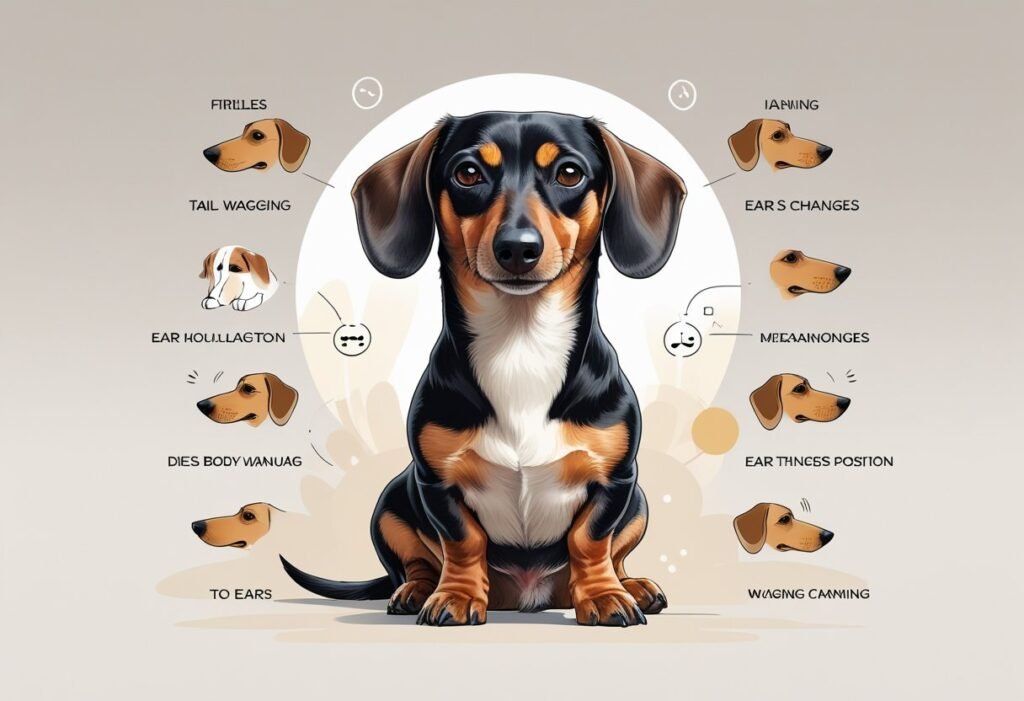
Dachshunds don’t just use their bodies—they’re pretty vocal and have all sorts of other ways to get their message across 🎤. These clever little dogs have their own sounds and even use scent marking to communicate 🐾. It’s just part of their charm, honestly 💛.
Vocalizations and What They Mean 🎶
Dachshunds are pretty chatty little dogs, and they’ve got a whole arsenal of sounds 🐕. Their barks can jump from sharp and high to deep and booming, depending on what’s going on 📢.
Common Dachshund Sounds:
- High-pitched bark: Usually means they’re excited or trying to get your attention about something 🎯
- Deep, repetitive bark: Often a warning—maybe there’s a stranger or something odd outside 🚪
- Growling: Signals they’re uncomfortable, scared, or guarding something they value ⚠️
- Whining: Typically, they want attention, food, or a bathroom break ⏳
- Howling: Sometimes happens when they’re alone or hear loud noises like sirens 📡
Some dachshunds even “talk” with a kind of mumbling sound when they’re happy or want to interact 🗨️. This talkativeness really ties back to their hunting roots, where staying in touch with their humans was important 🐾.

🧬 AnimalBiome – Gut Health Test Kit
- ✅ Discover how your Doxie’s gut microbiome affects mood & behavior
- ✅ Identify digestive issues that can change posture, energy, or signals
- ✅ Easy at-home sample with science-backed recommendations

🌿 Zumalka Calmpet – Anxiety Relief Drops
- ✅ Calm cues you can trust — soothing support during stress
- ✅ Helps reduce anxious body language (tucked tail, stiff posture)
- ✅ Natural/homeopathic option to help your Doxie feel secure
The Role of Scent and Marking 🌿
Dachshunds depend a ton on their noses for communication 👃. With about 125 million scent receptors, they’re basically sniffing their way through life 🔍.
When you see your dachshund glued to a spot, nose working overtime, they’re reading an entire chemical message board left by other animals 📜. It’s their version of checking “pee-mail”—and there’s a lot more going on than we’ll ever know 🐶.
Marking Behaviors:
- Urine marking: Not just about bathroom breaks—they’re sharing info about who they are, their mood, and staking out territory 🚩
- Ground scratching: After peeing, they might scratch to spread scent from their feet 🐾
- Rolling: If they roll in something smelly, they’re picking up info to bring home to you and the “pack” 🏡
You’ll probably catch your dachshund obsessing over spots where other dogs have been 🐕. They’re picking up a whole story we just can’t smell 🕵️.
How to Respond to Your Dachshund’s Signals
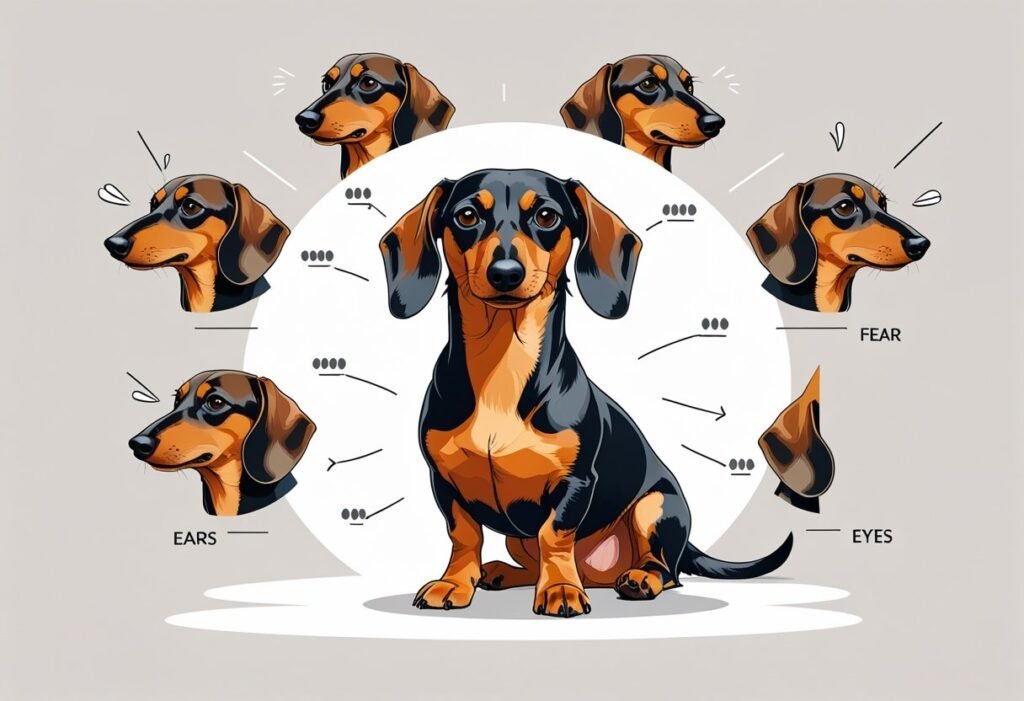
Getting the hang of your dachshund’s body language makes it way easier to meet their needs and connect with them 🐾. Once you start picking up on their signals, it feels more like a conversation than a guessing game 💬.
Building Trust and Strengthening Your Bond 🤝
When you respond to your dachshund’s signals the right way, you build trust 💛. If your doxie looks anxious—tail tucked, big round eyes—give them space 🌿. Don’t force interaction; let them come to you when they’re ready ⏳.
If your dachshund comes over looking relaxed and wagging, go ahead and praise them or play 🎾. This positive feedback makes friendly behavior more likely next time 🌟.
It’s the little things—bringing you a toy means playtime, standing by the door means they need out 🚪. If you’re consistent, your dog learns you get what they’re saying 🐶.
Trust isn’t instant ⏱️. Give it time and respect their boundaries, especially around new people or situations 🙌.

🍲 ChefPaw Fresh Dog Food Maker
- ✅ Prepare fresh, healthy meals at home
- ✅ Control every ingredient for your Doxie’s needs
- ✅ Saves money compared to store-bought fresh food

🌿 Wild Earth Plant-Based Dog Food
- ✅ Vet-developed, clean plant-based nutrition
- ✅ Supports healthy weight & long-term wellness
- ✅ Hypoallergenic & gentle on sensitive stomachs
Effective Training Techniques Using Body Language 🎯
Your own body language matters more than you’d think 👀. Stand tall but not intimidating when you give a command—your doxie will pick up on your confidence 💪.
Try pairing hand signals with words ✋. Dachshunds often catch on faster to visual cues than just your voice 🐕. Keep your signals clear and always the same 📌.
Key training signals to use:
- Palm down: “Stay” or “Settle” 🐾
- Open hand moving down: “Sit” 🪑
- Hand moving forward: “Come” 🚶
Timing is everything ⏰. Reward good behavior right away so your dachshund connects the dots 🎉.
Watch for signs your dog’s had enough—if they start looking away or licking their lips, it’s probably break time 😌. Short, upbeat sessions work best for both of you 🌼.
Common Misinterpretations of Dachshund Body Language

Dachshunds have some pretty quirky body language, and even seasoned dog folks get mixed up sometimes 🐾. That long, low body and those stubby legs make for some unusual postures 🐕.
Differences From Other Breeds 🐶
Dachshunds don’t always act like other dogs 🐕🦺. If you see one stretching out with front paws forward and rump in the air, it’s usually just a good stretch—not necessarily a play bow like you’d see in a lab or retriever 🐾.
Their alert stance can seem stiff if you’re used to bigger breeds 👀. But when a dachshund stands tall and ears perk up, they’re probably just curious, not picking a fight 🌿.
Tails are another thing 🚩. Dachshunds often carry their tails lower, so a droopy tail doesn’t always mean fear. It’s just their build 🐕.
And the barking? They were bred to alert hunters, so they’re naturally vocal 📢. People sometimes mistake this for aggression, but most of the time, they’re just trying to tell you something 💬.
🐾 Daily Comfort & Connection Tools to Understand Your Doxie Better
- 🍽️ Petlibro Automatic Feeder — Keep your Doxie’s routine steady with scheduled meals, helping you read hunger-related cues and maintain calm behavior throughout the day.
- 💧 Petlibro Water Fountain — Encourage hydration and health with a steady flow of clean water — a happy, hydrated Doxie shows relaxed, positive body language.
- 📸 Petcube Bites 2 — Monitor your Dachshund’s posture, expressions, and habits while you’re away — and toss treats to reward relaxed, confident behavior.
- 🪜 Majestic Pet Stairs — Support your Dachshund’s confidence and protect their back when climbing — relaxed movement means a stress-free, happy pup.
Avoiding Human Biases and Misreadings 🔍
It’s easy to see dog behavior through a human lens, but that doesn’t always work with dachshunds 🐶. For example, they might stare at you for a while—not to challenge you, but because they’re comfortable and trust you 💛.
If your dachshund digs at blankets or the couch, they’re not trying to ruin your stuff 🛋️. It’s instinctive burrowing from their hunting days 🪺.
Common misreadings to avoid:
- Assuming yawning means they’re tired (it’s often stress) 😌
- Thinking their stubborn pose is defiance (usually determination) 💪
- Confusing their aloofness with strangers for fear 🚪
How you handle them matters 👐. If you pick them up the wrong way and they squirm or growl, it’s not aggression—it’s discomfort from not supporting their long back 🩺.
When to Seek Professional Advice

Sometimes, your dachshund’s behavior is just too much for DIY fixes 🐾. Knowing when to get help from an expert can really turn things around 💡.
Persistent Problem Behaviors ⚠️
If you’re working on a problem and it’s not getting better—like barking that goes on for weeks—it might be more than a training issue 📢. That could be anxiety or something else that needs a pro’s eye 🐕🦺.
Serious aggression, like repeated growling, snapping, or biting, means you need to call in a professional ASAP 🚨. Don’t wait for it to get worse ⏳.
Major separation anxiety—chewing, drooling, accidents only when you’re gone—usually calls for outside help 🏡.
If your usually well-behaved dachshund suddenly starts acting weird—new fears, hiding, or lashing out—it could be a health problem 🩺. Call your vet to rule out anything medical 📋.
💛 Strengthen Your Bond by Reading & Supporting Your Doxie’s Signals
- 🎽 Embark Pet Adventure Harness – Encourage confident body language during walks with a harness that supports movement and prevents back strain.
- 🛁 Pride + Groom Grooming Tools Kit – Keep your Doxie’s coat clean and comfortable; gentle grooming helps them relax and show content body cues.
- 🌿 Innovet PurCBD Oil – Promote calm and balanced behavior; great for easing tension, anxiety, and restless signals in sensitive Dachshunds.
- 🎨 Purr & Mutt Personalized Dachshund Art – Celebrate your Doxie’s unique expressions with custom artwork that captures their personality and emotions.
- 👕 Dog is Good Apparel & Gifts – Show your love for Dachshunds with expressive apparel that lets your connection shine wherever you go.
🐶 Build trust, boost comfort, and better understand every tail wag and ear twitch your Doxie gives.
Working With Canine Behaviorists 🐕🦺
Look for trainers or behaviorists who know dachshunds 🐶. Certifications like CPDT-KA or CAAB are a good sign ✅.
A solid behaviorist will make a plan that fits your dog and your home 🏠. They’ll look at your dachshund’s background, personality, and how things work in your household 🐾.
Don’t expect miracles overnight 🌙. Changing behavior takes time and patience, plus sticking to the plan at home ⏱️.
Ask about their approach before you commit ❓. Stick with pros who use positive reinforcement, not punishment—dachshunds don’t respond well to harsh methods 💛.
Conclusion
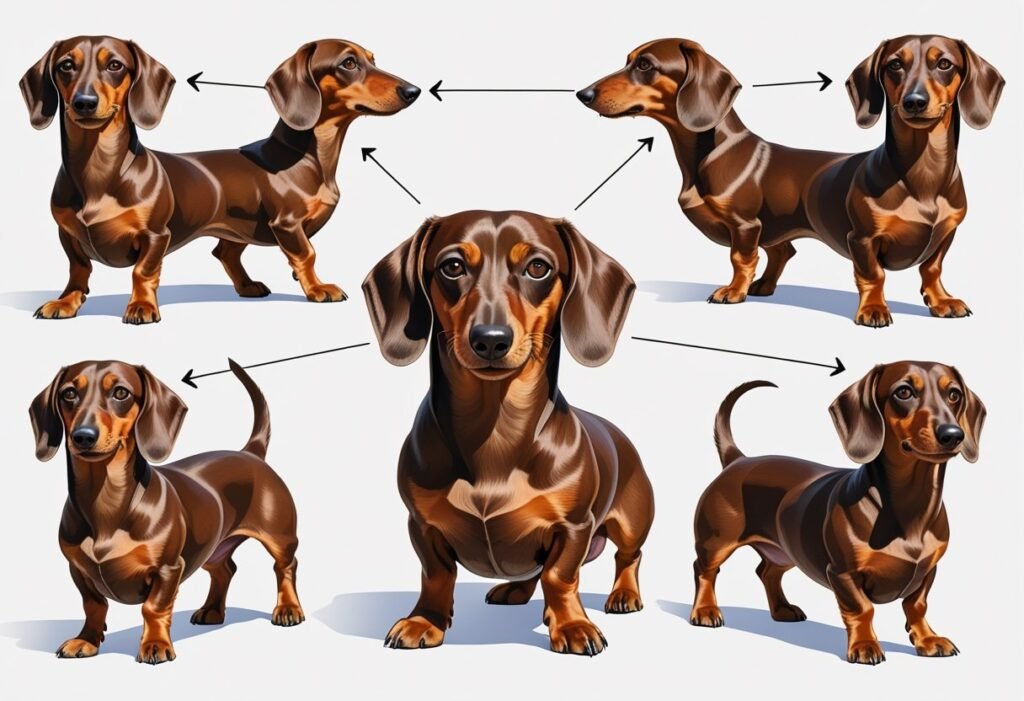
Learning to read your dachshund’s body language just makes life together easier 🐾. You’ll start to notice the little things—ear position, tail movement, the way they hold themselves—and get a better sense of what’s going on in their head 🐶.
Every dachshund’s a bit different, honestly 🌟. What looks like excitement in one might mean nerves in another 😌. There’s no substitute for just spending time with your dog and picking up on their unique quirks 💛.
Watch them in different situations—meeting new people, seeing other dogs, or going somewhere unfamiliar 👀. You’ll start to see patterns in how they react 🔍.
If you keep seeing signs of fear or aggression, don’t go it alone 🚫. A good trainer or vet can help you figure out the next steps for your doxie 🩺.
With patience, you’ll get fluent in dachshund language ⏳. It’s worth it—you’ll be able to give them the best care and really enjoy your time together ❤️.
🐾 Don’t Miss Out!
Download our free Dachshund care guide to keep your furry friend happy and healthy.
Get Your Free Guide 🐶Frequently Asked Questions
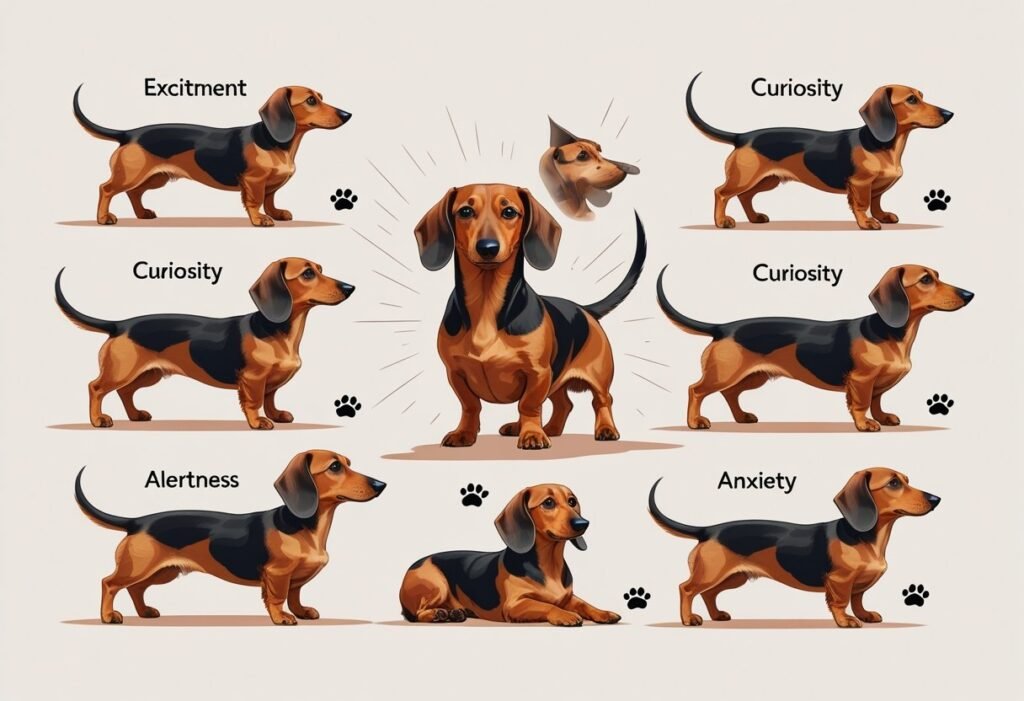
Dachshunds use all kinds of body language to “talk” to us 🐾. If you pay attention, you’ll pick up on what your doxie likes, needs, or feels 💛.
What are common signs of affection shown by Dachshunds? ❤️
When a dachshund leans their whole body weight against you, that’s love—plain and simple 🤗.
They might lick your hands or face gently, or just stare into your eyes 👀. It’s their way of saying you matter 🌟.
And if they bring you their favorite toy? That’s a big deal 🎾. Sharing toys means you’re part of their inner circle 💖.
How can you tell if your Dachshund is feeling anxious or stressed? 😟
If your dachshund is panting or drooling a lot when it’s not hot, that’s a red flag 🚩. Raised hackles along their back are another sign they’re on edge ⚡.
A tightly tucked tail usually means they’re scared 🐕. Some will try to hide under the bed or squeeze into tiny spaces to feel safe 🛋️.
Stress yawns are different from sleepy yawns—they happen when your dog’s uncomfortable 😌. Repeated lip licking with no food around is another sign they’re stressed 🌿.
What does a wagging tail typically signify in the body language of a Dachshund? 🐕
Most of the time, a loose, sweeping wag means your dachshund is happy and excited 🎉. The faster the wag, the more amped up they are ⚡.
If the tail is stiff and only the tip moves, they’re alert or maybe a bit tense 👀—just checking things out, not totally relaxed 🌿.
Slow, low wags can show uncertainty or submission 🤍. Always look at the tail along with the rest of their body to get the full picture 🔍.
Are there notable differences in body language between male and female Dachshunds? 🐶
Male dachshunds usually act a bit more territorial 🚩. You’ll see them marking, standing tall, or even puffing themselves up when they spot a new dog—especially if it’s another male 💪. They sort of want to make their presence known, you know?
Females, on the other hand, tend to keep things subtler 🌸. They’ll use softer cues to show what they want or don’t want, and sometimes you really have to pay attention to catch those signals 👂.
Honestly, though, most of their body language is pretty similar 🔄. It’s really the dog’s unique personality that shapes how they communicate, way more than whether they’re male or female 💛.
What behaviors indicate that a Dachshund has chosen their favorite person? 🥰
If your dachshund follows you everywhere—like, you can’t even go to the bathroom alone—that’s a solid sign you’re their chosen human 🚶♂️. They just want to be where you are, plain and simple ❤️.
Does your doxie get extra wiggly or vocal when you come home, more than with anyone else? That’s not just coincidence 🎯; they’re showing you’re their top pick 🏆. Some might even jump or do a happy dance just for you 💃.
When things get stressful, like during a thunderstorm ⛈️, and your dachshund seeks you out for comfort, that’s trust right there 🙌. And if they always try to sleep pressed up against you, well, you can pretty much bet you’re their favorite 🛏️.
How do Dachshunds typically communicate their needs or desires to their owners? 📢
Dachshunds use a mix of vocalizations—whines, barks, and the occasional grumble—to get their point across 🗨️. The pitch and volume usually ramp up if they really need something ⏰.
They’ll paw at things like their food bowl or the door when they want attention 🐾. Sometimes your doxie will drag over a toy or just fix you with one of those long, meaningful stares if they’re hoping for playtime (or maybe just a treat?) 🍪.
Their body language says a lot, too 💬. If they park themselves by the door, they probably want out 🚪. Standing next to the leash? That’s their way of saying, “Let’s go!” 🐕🦺. Over time, most dachshunds settle into their own little routines, and honestly, you just sort of pick up on what each signal means 🔍.



